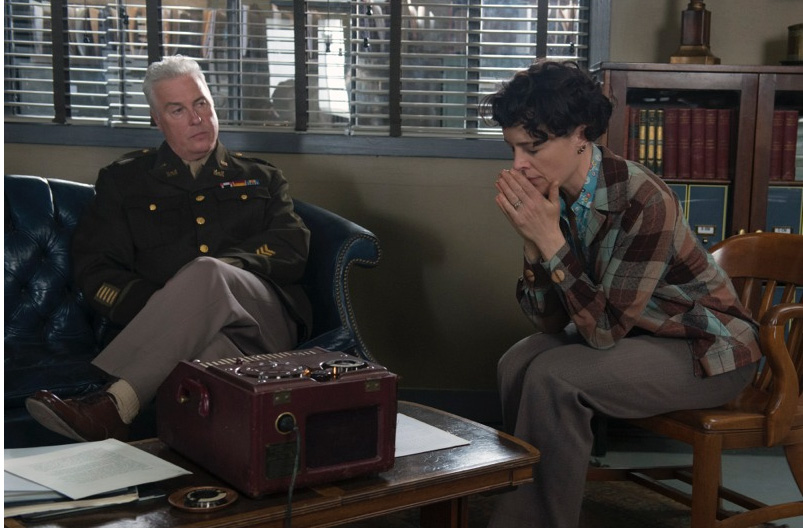Season two of “Manhattan” begins with a bright, mysterious light. Is it the explosion of an atomic bomb? In the opening scene, we flash forward to July 16, 1945, the morning of the Trinity test. The Gadget dangles from its tower in the pouring rain. We see familiar characters frantically preparing. Charlie Isaacs, who took over the implosion project at the end of season 1, fends off a journalist; Fritz Fedowitz worries about the weather (in fact, the Trinity test was delayed by an hour and a half due to a thunderstorm). But one person is missing: Frank Winter, whom we last saw with a bag over his head, being driven away from Los Alamos.
After the opening credits, the action resumes in early summer of 1944. The question “Where’s Frank?” is on everyone’s mind. Nobody at Los Alamos appears to know except the military, and they aren’t telling anyone – not even his wife, Liza. Liza knows the cover story that Frank suddenly transferred to another site is false. “All his clothes are boxed up at the house. He even left his security badge. Does that sound like a transfer to you?” she asks Charlie. Since Frank disclosed to her the true nature of the project, she is not permitted to leave Los Alamos.
Change is afoot on the Hill. Colonel Cox, the military commander at Los Alamos, is gone, replaced by steely Colonel Emmett Darrow. “God buried an atom under a million tons of rock so that America could split it in two and redraw the maps of the world,” Darrow rebukes Paul Crosley, who begs him to be transferred to the Manhattan Project’s polonium trigger site in Dayton, Ohio so he can avoid working under Charlie. “And you want to run off to Dayton because some girl didn’t ask you to the prom?”
Meanwhile, Charlie has moved into Reed Akley’s office. Now in a position of power thanks to Frank, Charlie turns the tables on Avram Fischer, interrogating him about Frank’s whereabouts. While Fischer won’t disclose where Frank is, he reveals why his own history as an immigrant from Eastern Europe makes him so relentless in his pursuit of spies on the Hill. “When you’ve lived in a place where borders have no meaning, borders come to mean a great deal. Twenty years I’ve lived in this country, yet still I keep a packed suitcase by the front door.” Avram’s story echoes those of real-life Manhattan Project scientists whose fictional counterparts he is investigating. Many of the project’s most brilliant scientists were European refugees, including Leo Szilard, Edward Teller, Enrico Fermi, and John von Neumann.
It appears season two will also explore the relationship between Charlie and the director of the Los Alamos Laboratory, J. Robert Oppenheimer. The leading scientists on the Hill, skeptical of the implosion plan, view Charlie as Oppenheimer’s puppet. “Oppenheimer picked you because he knows that he can control you,” Helen Prins tells Charlie. As Charlie announces the reorganization of the project to the other scientists at Fuller Lodge and vows to test a bomb by July 4, 1945, Oppenheimer watches from above, God-like.
While the program captures the awe that many project scientists felt for “Oppie,” in real life he was much warmer than the distant, controlling figure depicted on the show. For example, Oppenheimer was instrumental in getting project scientists to work together through weekly colloquia. “I could see how these people adored Oppenheimer…it was Oppenheimer, this fearless leader, who carried this thing through,” recalled scientist Fred Vaslow, who worked at Los Alamos.
This episode also continues Manhattan’s focus on espionage. Jim Meeks, revealed as a spy in the final moments of last season, immediately attempts to pass along news of Charlie’s announcement. Jim’s messages are hidden in pages of Shakespeare’s Julius Caesar, a neat parallel to actual Manhattan Project spy Ted Hall, who used a code based on Walt Whitman’s Leaves of Grass. Fischer, who has followed Jim to a forest outside Los Alamos, confronts him. But before Jim can start talking, Fischer, uncharacteristically off-guard, is attacked and killed by Jim’s unknown spy contact. Jim can continue to spy – for now.
The episode concludes with another flash forward to Trinity. Someone needs to safeguard the bomb until the moment of detonation, but who? Jim volunteers: “It should be someone you trust.” He climbs the tower to the Gadget, holding a gun.
In real life, chemist and explosives expert Donald Hornig was asked to “babysit” the bomb in the thunderstorm. “I don’t know if it was that I was most expendable or best able to climb a 100-foot tower!” he remembered. An interview with his wife and fellow Manhattan Project veteran Lilli Hornig, a chemist at Los Alamos, is available on our Voices of the Manhattan Project website.
We are glad that the show continues its focus on the challenges and opportunities for women on the Manhattan Project. Liza continues to feel trapped at Los Alamos. Helen, whom Charlie dismisses as unable to stand up to Oppenheimer, continues to fight for her colleagues’ respect. Bustle.com has an illuminating interview with Manhattan’s leading actresses about their characters’ struggle for agency.
“The ones who survive are the ones who adapt,” Fischer tells Charlie. At the end of the episode, Colonel Darrow orders his soldiers to arrest Frank if he shows up at the test – a clue that we may be seeing Manhattan’s master adapter soon. Is Frank’s return to Los Alamos in the cards? We look forward to learning more next week!





